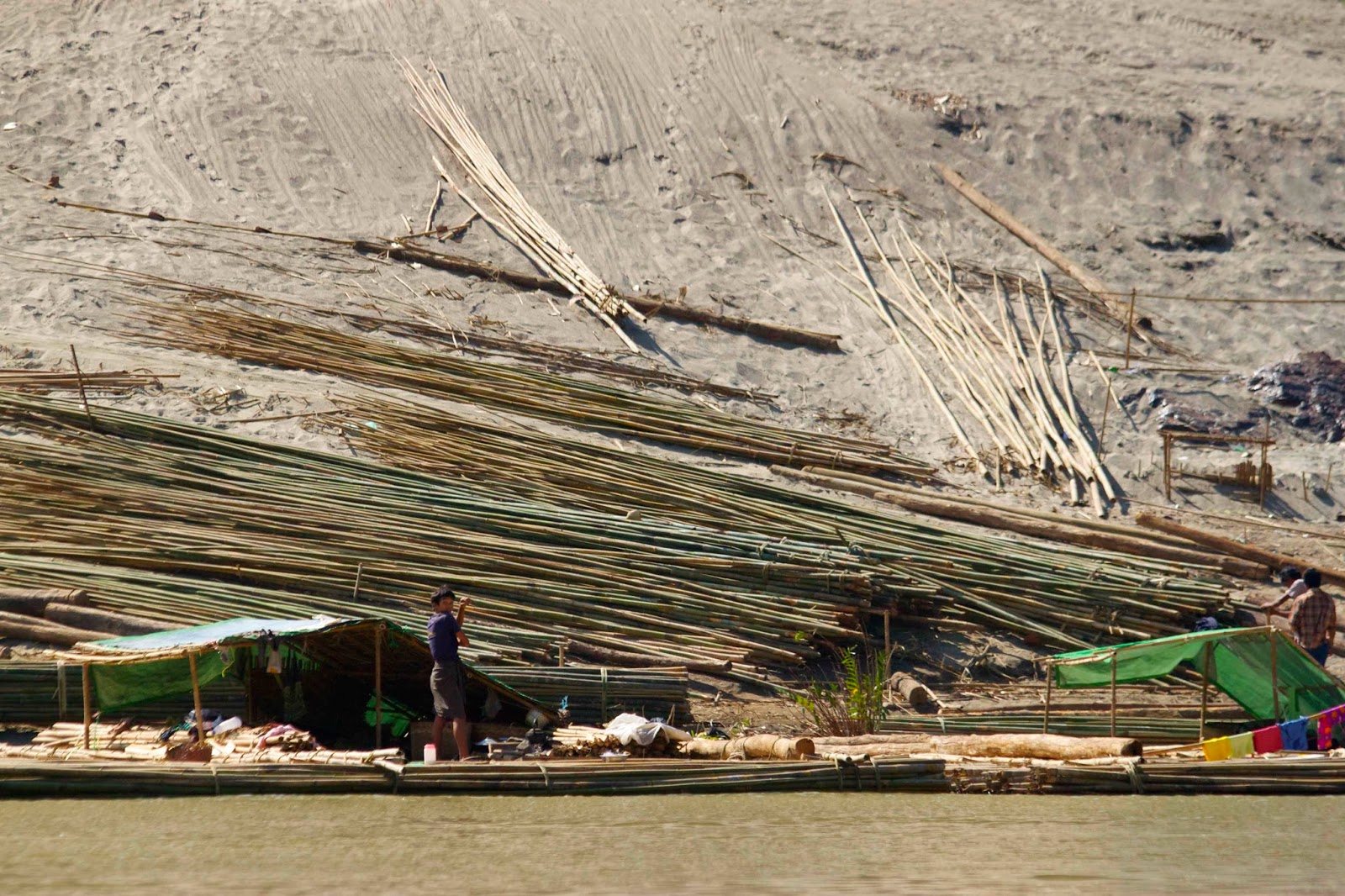As the bed at Sinbo was just a rafia mat on a board we were smug
that we'd brought our own sleeping bags and a bedding rafia mat each as, at
least mentally, we were more comfortable. Although the cockerel crowing
competition started at five, and the pigeon race on our tin roof was hotly
contested, we arose well rested.
We watched the ladies preparing lunch as we ate our breakfast of
bananas and green tea, seated next to a giant poster of Avril Lavinge. Small
cauldrons of chicken pieces in a red sauce, stir fried broccoli, slightly
mashed chick peas, boiled eggs in sauce and steamed rice were set out. The
round stacked tiffin boxes then appeared, soup went in the first layer, then
each compartment was filled in turn. Some portions had chillies added, others
got no meat - depending on the diners preference. Once stacked the tin layers
where secured and the tiered lunch box was ready to go. Beats a pre-packed
sandwich any day!
On Friday 24th we caught a small ferry boat out of Sinbo at 10.30am.
It carried an average of 10 people and left promptly. The monk had the best
(largest) seat. The encircling terrain became hilly. The river was cutting down
and we passed through rocky outcrops and pebbly shores. The flowing water was a
constant murky brown and did not entice us to have a dip. The combination of
the natural resources surrounding the river and the relatively cheap
transportation means provided by the downstream flow has lead to many small
communities eking out a living from the land.
We could see paths leading up from the bank into the woods. A large
amount of bamboo had been cut from the forest. It was bundled up into stacks
like hay, then these were lashed together to make very large rafts. Little
hamlets of the grass cutters families lived on these rafts. When enough bamboo
had been harvested the whole raft was floated downstream with houses, mothers
and children on board. Bamboo is widely used to form the girders and walls for
buildings such as houses and schools. Alongside the river we saw many
basic bamboo houses and shelters. It's also used to make all types of furniture,
scaffolding, cooking utensils - it's a pretty versatile raw material.
Dark wood chips on the shores were signs of teak felling. Removed
from the forest in the dry season these giants were cut into planks or posts
and floated down river. I read that Myanmar 'holds 75% of the worlds teak
reserves'. Maybe this is a relative claim as I'm not sure there are many of
these highly prized hardwood left in the hills.
The gold mining camps were prolific and vast sways of riverbank had
been blasted away by jet washing. Every few hundred metres a small group of tents
worked their claim, families or small gangs, washing, sluicing, panning and
living. There were boats working in groups in search of these deposits, washing
the sediment down afro-turf sluices. Ladies panned the sparkly dirt collected
in the afro-turf seeking the precious flecks.
We had numerous stops at gold camps or nameless sand banks to
collect or drop off passengers or cargo (often diesel, once a motorbike).
Once through the hills the Ayeryarwady River stretched wider and
occasional coconut trees appeared on the shores. More settlements dotted the
banks, some well established with stupas. Pigs, buffalo and chickens wandered
about. The land flattened out and crops of maize became more frequent.
Passing young men washing in the harbour channel next to piles of
plastic rubbish we made Bhamo about 4pm. Hotel choice was limited because, as
foreigners, we are restricted where we may stay. We'd booked ahead at the
'Friendship hotel' and enjoyed a hot shower. The hotel provided a good range of
complementary room toiletry goodies; the most unusual was the tea-flavoured
toothpaste.
We chose a nearby restaurant for dinner and were pleasantly
surprised at how good the food tasted. Chris went for fried chicken and Thai
fried chicken rice, I had garlic pork ribs and a spinach dish. When the bill
arrived it was much more than expected and so Chris raised the matter.
Mysteriously the bill was soon reduced, albeit with profuse apologies from the
owner.
Lunch being transferred into a lunchbox tier at Sinbo, you can see the stacked tin lunch boxes on the shelf behind
Down the river with our fellow passengers on a much smaller boat
Motorbikes at the front and monks in the middle, everyone else fills in the gaps
The larger more established mining camps have shops, the women wash the clothes whilst the men rest in the shade
These bamboo rafts can hold a number of families or work gangs, sheltering under makeshift tarp tents
The camps are seasonal as the water level is to high in the wet season, hoses wash the silt from the bank through sluice traps
Some sluice designs have matting at the bottom (like astro-turf) to catch the heavier minerals
Some stretches where deposits are greater have small camps every few hundred metres
Some more established camps can be worked nearly all year round on the upper slopes
Gasoline is a common cargo for generators and water pumps
A boat is an essential commodity here, few roads or tracks reach the river at these upper reaches
Bamboo harvested from the forest to be exported downstream
Fellow passengers hailing a ride
Women panning the residues from the traps to reclaim their precious flecks
Taxi!!
Some bigger operations using boats sluice at one end and live at the other
Our fellow passenger the monk disembarked
The two essential modes of transport for this region, the boat and the ox
























Raw but awesome ��xxx
ReplyDelete